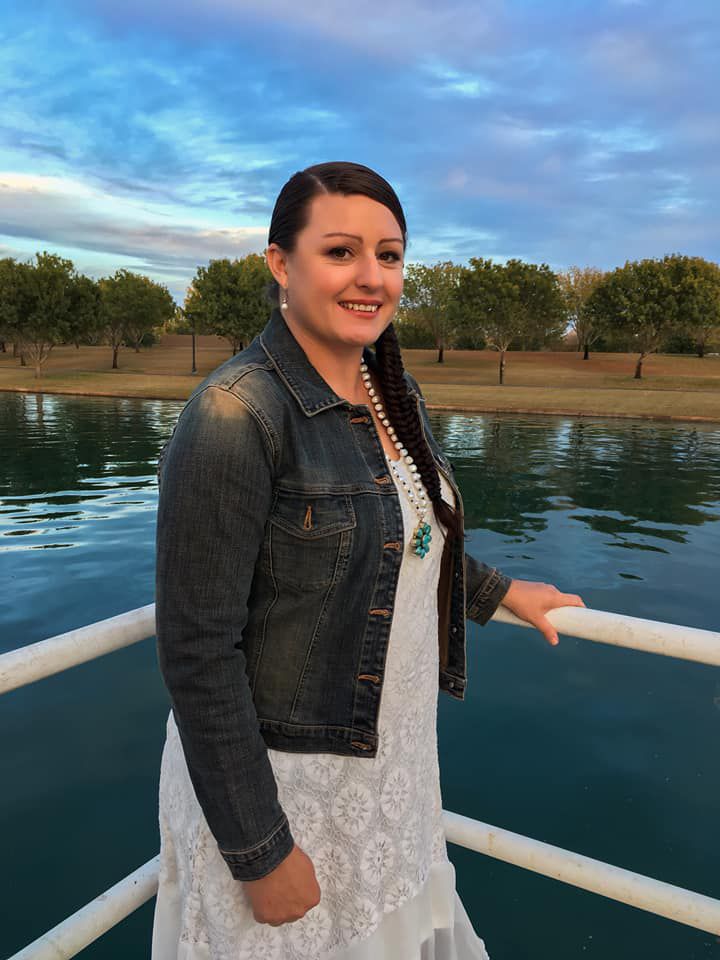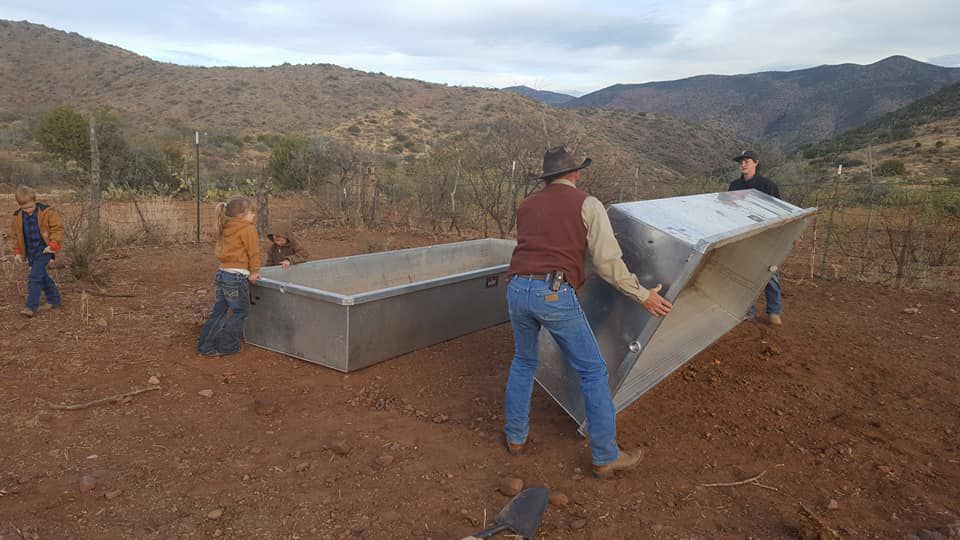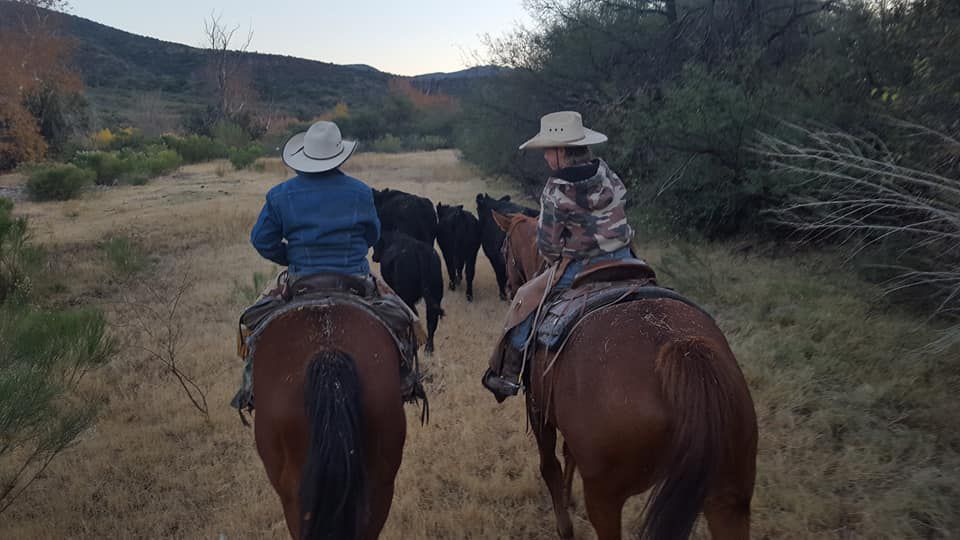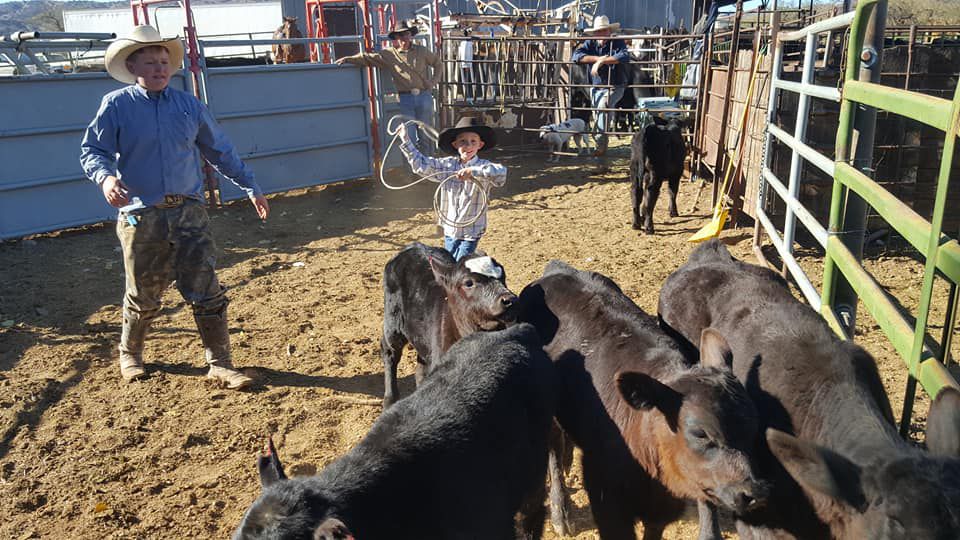Meet Arizona Agriculture’s Lyman Family
Author
Published
1/9/2018
The American Farm Bureau Federation’s 2018 Annual Convention & IDEAg Trade Show in Nashville, TN just concluded. One of our Arizona ranchers comes back a national winner. Fourth place Young Farmer & Rancher Achievement Award winner Cassie Lyman of Arizona received a Case IH 40” combination roll cabinet and top chest and a $500 Case IH parts card, courtesy of Case IH.
Winners of the Young Farmers & Ranchers Achievement Award, Discussion Meet and Excellence in Agriculture competitions were announced yesterday. Young farmers and ranchers from around the country competed for the awards by demonstrating knowledge of and achievement in agriculture, as well as commitment to promoting the agriculture industry.
But that’s not all this ambitious young rancher has achieved. Currently, the new Gila County Farm Bureau President, Lyman also just finished her leadership as chair of Arizona Farm Bureau’s Young Farmer and Rancher last November. So, while she hops around the country to win national awards, she does find time to be a wife, mother and rancher. Here’s the Lyman Story.

Cassie Lyman competed this year in the Young Farmer & Rancher Achievement Award in Nashville and placed 4th nationally.
An interview with Cassie Lyman of Payson, Arizona
Part of an ongoing series of Arizona’s farmers and ranchers
Tell us about your ranch operation ? I am a first-generation agriculturalist who married a sixth- generation cattle rancher. Though I was not born into the industry, I have embraced it with all my heart. I grew up participating in 4-H, FFA, Breed Shows, High School Rodeo and Rodeo Queen contests. My senior year of high school, I could have graduated early but instead I took college courses to get ahead in my education. After graduating high school, I continued pursuing my college degree, taking classes such as intermountain beef management, family development, beef reproduction and family history.
The Lyman family celebrate Cassie's 4th place finish. The entire Lyman crew were in Nashville including husband, Jared, and their four boys.
After meeting my husband, Jared, I decided to put my education on hold and trade my BS degree in for a Mrs. Degree, get married, and start our family and our cattle business. We have been married for 16 years and have 4 energetic boys who love the western way of life and are also a part of the daily operations on the ranch. Because of the location of our ranch, I homeschool our 3 oldest boys.
This gives us the ability to integrate everyday activities into our classroom studies. I have many different hobbies and I love to serve, especially in our church, my community and the Farm Bureau. I have been a 4-H leader for 14 years and I have had the opportunity to help organize a Collegiate Farm Bureau chapter, a High School FFA Chapter and participate in summer Supervised Agriculture Experiences. I was the state Chair of my Young Farmers and Ranchers and recently organized a new county Farm Bureau in my area.
Lyman Ranches, LTD is a ranching corporation my husband I created for tax purposes and asset protection. Together we own 100% of the Hat Ranch and 36% (lease 64%) of his parents Bar L Bar Ranch. Both cattle ranches lease all cattle to our corporation.

My husband and I are equal partners not only in our marriage but in our business. I love that I am involved with the decisions that affect the day-to-day operation and productivity of our ranches. As an equal partner, I assist in making the decisions on finances, herd genetics, sire selection, cull-cow planning, pregnancy testing, artificial insemination, branding, animal identification, herd health, pasture rotation, heifer development, calving, calf sales, fencing, water development and maintenance, and other routine tasks. I not only help make decisions, I'm also involved with the hands-on processes associated with them. For example, I've taken a beef reproduction class and artificially inseminate our heifers. My favorites tasks are riding the range on my horse, working alongside my family during branding, diagnosing and treating animals, and sharing our passion for the ag industry.
Specifically, our family raises commercial Angus-cross cattle on 37,000 acres of National Forest (public lands), which adds to the challenges of cattle production. Ranching on public lands gives us the opportunity to manage the natural resources of range land forage of our cattle operation, while successfully producing a 90 percent calf crop. Recently, my husband and I purchased our own ranch and have overhauled the previous owner’s management practices on the ranch. We have goals to continue making changes that will increase the ranch's productivity and sustainability. Originally, the ranch has managed to wean and sell calves at 700 to 800 pounds. Allowed carrying capacity on the allotment was 75 cows and 35 yearlings. Working with the Forest Service, we proposed a change in carrying capacity by converting carry over (yearling) numbers to full grown cows. Because of this and our efficient management practices, the operation is now allowed 124 animal units on the allotment. We also began weaning calves in the fall at 400 to 500 pounds. Cows are now better able to hold their body conditioning through the winter as a result. Bulls are no longer left with cows year-round allowing for a more uniform calving cycle and better grouping of calves at time of sale. Herd genetics are being changed from primarily white cows to black cows to increase profitability. This transition will take several generations of cattle. The operation also has 28 acres of private irrigated pasture where we grow seasonal grasses to pasture feed cattle including the ranch's replacement heifers. In partnership with my father in-law, we irrigate an additional 24 acres of private grass pastures and 30 acres of leased irrigated pastures. This partnership allows us to graze an additional 45 head of our operation's mother cows, our ranch's 14 working horses and 3 to 5 head of calves we raise for direct selling as 1,350-pound pasture raised/corn finished beef.
Describe significant changes, expansion or improvement in management and marketing practices you’ve carried out on your ranches . We knew when we started our ranching career there would be a lot of challenging work both physically and mentally, but I live by the motto, "Anything worth having takes hard work!" With the future and the sustainability of our ranching operation in mind we knew what our goals were and what we needed to do to accomplish them. Some of the changes included improvements in our gate-to-plate program, genetics, herd management, and improvements on the ranch and range land that we manage. The first step was changing our career paths, moving back to my husband’s family’s ranch and forming a partnership with my in-laws. This change allowed us to grow our operation, increasing our herd size over the past several years to 8.5 times what we started with. This has also increased our profitability. After obtaining ownership of our 40 head of cattle that we had leased to my in-laws, each year purchasing additional cows and saving replacement heifers with another 130 cows that we recently leased, we now manage 350 head. We have implemented a herd health program vaccinating for healthier breeding cattle and preventing disease and pests. By improved genetic selection and purchasing bulls that have the genetic traits desired we increased our calf marketability.
In years past, we would sell small groups of 30 to 50 calves at a time directly to the auction barn. With the purchase of the Hat Ranch, not only did we almost double our herd size, but we were now able to group the ranches' calves. Grouping the 255 calves allowed us sufficient numbers to send calves to a grow yard where they are corn finished, maximizing on weight gain and market variables.
We made improvements to fences on the ranches’ borders and added signage on the Forest Service gates within the allotments to help keep cattle in correct pastures. Fencing has never been one of my favorite projects, but it is another opportunity to teach my children the value of challenging work as we stretch barbed wire over miles of rough terrain.
As public land ranchers, our connection and involvement with educating recreationists, hunters and tourist groups on land ethics while on public lands is critical. I enjoy sharing my Ag story and have made it my priority to be our ranch spokesperson. Frequently I attend and host informational booths for these groups through my involvement in Farm Bureau and other industry groups.
Our children love when we get to work on our goal of improving the irrigation systems at each ranch. The irrigation ditches and head gates were in disrepair and full of overgrown trees, brush, and debris when we arrived at our in-laws ranch the Bar L Bar. The Hat Ranch wasn’t much different; the diversion and ditches were only allowing ¼ of our permitted water to flow through when we obtained ownership. The irrigated pastures on both ranches had to be cleared of mesquites, increasing grass production and water conservation. We have cleaned, cleared and fixed the irrigation systems ourselves with a shovel and with our backhoe. The natural waters on public lands are few and far between on our ranches. Improving the availability of water for our cattle and wildlife not only changed the management of our rangeland, but can lead to the future increases in cattle permitted on our allotments. We have also repaired, cleaned, and installed new drink tanks on springs as well as cleaned dirt collection tanks across the Bar L Bar Ranch. We are now changing the watering system on the Hat Ranch allotment to a solar water pumping system increasing efficiency and decreasing labor and profit loss. Watered in most pastures by an artesian spring, we also pump over 800 feet in elevation to several 10,000-gallon storage tanks across the allotment where water is then gravity fed along miles of pipeline to float-controlled water troughs.
Converting our allowed grazing numbers on the Hat Ranch from 75 cows and 35 carry over to 110 cows was one of the first range management changes we made on the ranch. Pulling from our past experience in range management, through my husband's career with the BLM and my time working for the NRCD, we utilize the Reading the Range Program (RTRP). We worked with our Cooperative Extension Agent to create key areas on the Bar L Bar Ranch to implement the RTRP, so we can collect data, alongside Forest Service and University Extension staff, on forage production and utilization. By submitting the sound science to Forest Service that this program provides, we were able to make an increase in the grazing unit conversion on the Hat Ranch. We will continue to utilize this ranches 13 years of collected studies for future range improvements. I’ve worked alongside my husband in creating a vision for our family’s legacy in agriculture. Knowing we will one day pass our ranch on to one or more of our children, their involvement (even at an early age) is key to their future success just as these significant changes have led to our success.

What are your future plans ? As we work toward our goal of increasing herd size, we plan to continue to make range improvements so that we may have an opportunity to increase the number of animal units permitted on both of our allotments. We have plans for additional pasture fences across public lands, so we are able make changes to grazing schedules. We also desire to add additional water lines and water troughs in remote areas of our allotments. It is very difficult to get range improvements approved on public lands because of all the burdensome regulations put upon us. It will take a lot of work with Forest Service staff and an administration that is supportive of public land grazing, but it is a goal we are working toward. Our plans for expansion also include the purchase of an additional ranch. We are currently looking at a ranch that would increase our herd to 500 head. This purchase would allow for an additional partnership with my husband's brothers and their families. We must be creative with our financial resources and feel secure that it is a viable investment. We are weighing the profit and loss of the ranch, meeting with Forest Service staff, and reviewing potential partnership agreements. The next step is getting an accepted offer.
We envision our gate-to-plate program increasing sales directly to the consumer. For this increase we need to change some of the infrastructure of the ranch. At this point we do not have the facilities/space to finish more cattle. We need to purchase a set of scales, feeder system, and paneling for corrals. There is also a shortage of USDA inspected and state inspected harvest facilities in our state making it harder to get cattle processed in a timely manner. We have plans of opening an on-sight full butcher shop on our ranch where we can harvest and sell direct to consumers. We already have a local restaurant interested in partnering with us on the endeavor. I love sharing the Ag story and working with youth. It would be helpful to our budget if I was paid to do these things. As we look toward future expansion of our ranches, the best way to bring these components together is to increase the educational component of the ranch. We plan to include a for profit ranch camp for kids where they can learn outdoor skills and how to be a rancher.

Our goals over the next five years are vital to the success of our ranch. We will continue to work from the ground up repairing our ranches, creating a sustainable operation that is better for the environment, our herd, and our bottom line. Some of these goals include continuing improvements to our herd and facilities through better management practices. Our vision is to ensure the secession of our business for generations to come. It is our goal to increase consistent water availability across the Hat Ranch by adding an additional waterline with one to three new waters within the next two to three years. We will start by submitting the proper documents to Forest Service office for a requested approval of a new pipeline, also requesting required archeological studies needed for this approval. Our plan is to acquire funding from the State Game and Fish Department and local Mule Deer Foundation to purchase needed supplies. We will work alongside our four boys to provide the labor needed to install the new watering system. We have started the process of replacing diesel generator water pumps to a complete solar pumping watering system and it is our goal to have this complete within the next five years.
Another future goal is to have the cattle herd on the Hat Ranch culled of original cows and undesired genetics to a mostly Black Angus Cross herd. We also desire a 95 percent calf crop. We plan to achieve these goals by implementing a new tagging and record keeping system for the Hat Ranch, culling 10 percent of grown cows each year, and saving replacement heifers that only have the traits desired for our future herd. Through modern ag practices we will continue to learn more and implement new vaccination protocol and pest management control. In a world where social media dictates how food is grown, impacting regulations, we need to continue learning how to better our gate to gate program.
Currently we are living at the Bar L Bar Ranch with my in-laws. Within one year we have set a goal of completing the Hat Ranch house remodel so the house can be fully functional and livable. The Ranch house’s well is problematic, inconsistent, and dries up in the summer. The solar system for the house is also very outdated and is insufficient to run a household. Because the Hat Ranch is completely off the grid, these improvements must be made for the house to be suitable for habitation
We will also have an agriculture tourism component on the Hat Ranch by the year 2023, where youth will pay to come to the ranch and learn how to be future ranchers. I am passionate for agriculture education and youth development, so adding this component will give us the opportunity to not only increase ranch income but also seed future agriculturalists. While attending the week-long Hat Ranch Camp, youth will learn basic outdoor skills, animal care, Dutch Oven cooking, horseback riding, fence building, routine ranch chores, roping, animal doctoring, cattle nutrition and public lands grazing, plant identification, proper firearm handling and gun safety, and the importance of physical fitness. The target age group will be 12 to18-year-old boys and girls. It has been my goal since moving into our county five years ago to form a County Farm Bureau where I live.
Achieving this goal and being elected to serve as the County's Farm Bureau President, has been a highlight of my year. As newly elected County President, I have set goals for our county to have a fully functioning board and active county programs within the next two years. I am working to achieve these goals by informing area Farmers and Ranchers of the organization and the individual leadership and business benefits of being a member.
Continuing to live by example, I am teaching new members of opportunities to serve in the Women’s leadership, Young Farmers and Ranchers, and Ag in the Classroom programs. Working with our County Farm Bureau Board we are developing a program of work to help us measure the success of our goals. I have set a personal goal of teaching at least 1,500 students a year through the Farm Bureau Ag in the Classroom Program and plan to keep reaching this goal every year for the next five years. Last year I taught over 1,944 students and teachers! On a national level, I would like to be selected for the next class of Partners in Advocacy Leadership were I hope to further my leadership skills. Being an active member in industry organizations, I serve in our County Cattle Growers organization as a County Cowbell Board member. I have a goal of serving as an officer within this organization in the next five years, having a greater influence on the groups program of work in our community. These self-initiated improvements are building a better business and reducing our debt over time, giving a leg up to the next generation in an industry full over regulation.
List your community and agriculture leadership engagement ?
· County Farm Bureau President (2017-Present)
· County Policy Development Meeting and Annual Roping (2014, 2015)
· Represent County Farm Bureau at County BLM Travel Management Plan Meeting (2013)
· County Representative at Farm Bureau Women's Conference (2013)
· Bi-Annual Farm Field Day Committee- Presenter and Assistant (2013, 2011, 2009)
· County Farm Bureau FBACT (Farm Bureau Agriculture Contact Team) Coordinator (2013)
· Farm Bureau Young Framer and Rancher Leadership Conference-Member Spotlight Recognition (2012)
· County Farm Bureau Women's Committee Member (2012 - Present)
· County "Food Check Out Week" and "Share a Book Tell Your Story" Organizer (2012 - 2013)
· County Farm Bureau Delegate: Voting Member at State Annual Farm Bureau Convention (2012 - Present)
· County Farm Bureau Vice President; County Issue Surfacing Meeting Organizer as V. Pres. (2012 - 2014)
· Collegiate Farm Bureau Chapter and Collegiate Discussion Meet Organizer (2012)
· District Farm Bureau FFA Discussion Meet Committee Member and Coordinator (2010-2012)
· District Farm Bureau FFA Discussion Meet Judge (2010, 2012, 2013)
· Bi-Annual Natural Resource Day Committee- Presenter and Assistant (2010, 2012)
· County Farm Bureau Young Framer and Rancher Committee Member (2009 - Present)
· County Representative at Farm Bureau Young Farmer and Rancher Leadership Conference (2009 - 2013)
· County Farm Bureau Young Farmer and Rancher Chairman (2009-2011)
· Agriculture in the Classroom Presenter (2008 - Present)
· County Farm Bureau Issue Surfacing Committee Member (2008-2013)
· County Farm Bureau Member and County Board Member (2007-Present)
List Specific Leadership Roles .
· State Farm Bureau Board Member (2015-Present)
· State Farm Bureau Young Farmer and Rancher Chair (2015-2017)
· American Farm Bureau Collegiate Discussion Meet Judge (2017)
· State Farm Bureau Young Farmer and Rancher Vice Chair (2015)
· American Farm Bureau Excellence in Agriculture top 10 Finalist (2016)
· State Farm Bureau Women’s Committee Legislative Outreach Day (2014, 2015)
· State Farm Bureau Young Farmer and Rancher Committee Member (2011-Present)
· State Farm Bureau Women’s Committee Member (2013-2015)
· District Farm Bureau Women's Committee Chair (Representative on State Women's Board) (2013)
· State Farm Bureau Training/State Capitol Representatives Relations Attendee as County V. Pres. (2013)
· State Farm Bureau FFA Discussion Meet Judge (2013)
· State Women's Delegate- Voting Member at AFBF 94th Annual Convention (2013)
· American Farm Bureau Young Farmer and Rancher Leadership Convention Attendee (2013, 2012, 2015, 2016,
· 2017)
· District Farm Bureau Women's Committee Chair Training: Presenter and Organizer (2013)
· American Farm Bureau Women's Convention Attendee (2013)
· State Farm Bureau Young Farmer and Rancher Discussion Meet Final Four Moderator (2011)
· State Farm Bureau Century Club Member (2011-2013)
· State Farm Bureau Young Farmer and Rancher Excellence in Agriculture Contestant (2011-2015)
· State Farm Bureau Young Farmer and Rancher Congressional Relations Trip Attendee (Washington DC) (2011)
· American Farm Bureau 92nd, 94th, and 98th Annual Convention Attendee (2011, 2013, 2017)
· American Farm Bureau Young Farmer and Rancher Discussion Meet Contestant (2011)
· District Farm Bureau Young Farmer and Rancher Chair (2011-2012)
· State Farm Bureau Young Farmer and Rancher Discussion Meet Contestant and Winner (2010)
· Farm Bureau Western States Leadership Conference Attendee (2010)
As it relates to your community?
· Connections Academy Home school- Home School Learning Coach/Teacher (2016- present)
· Local School District- School Health Advisory Council (2017-Present)
· Kindergarten- 2nd grade Elementary School- Volunteer of the Year Award (2014)
· Saint Vincent De Paul- Food Bank Packer (2014 - 2016)
· Parent Teacher Organization (PTO)- Vice President (2013 - 2015)
· Community Development Committee- Playground Development Member (2012 - 2014)
· County Systems of Care Committee- Member (2012)
· School Parent Community Council- Co-Chair / Chair (2011-2012 / 2012-2013)
· School District Teacher Evaluation Committee- Parent Member (2012 - 2013)
· School District Hiring Committee- Parent Member (2011-2013)
· County 4-H Youth Development Program- Interview and Dating Skills Workshop Host (2011-2013)
· Community Bantam Wrestling- Parent Assistant (2011-2016)
· Operation Military Kids- County Hero Pack Organizer (2010 - 2012)
· Church of Jesus Christ of Latter Day Saints- Family History Genealogy Consultant (2010 - 2011)
· High School Senior Project Interview Committee- Panel Member (2009-2013)
· Community Awareness and Development Committee- Organizing Member (2009-2011)
· Teen Reaching Youth- Gold Award Winner (2009, 2011)
· Youth & Families with Promise Mentor Program- Facilitator and Mentor (2008-2011)
· Church of Jesus Christ of Latter Day Saints- Primary Councilor
· (2008-2011,2013-2015)
· Church of Jesus Christ of Latter Day Saints- Young Women’s President (2011-2013, 2015-Present )
· Community Heritage/Pioneer Festival- Activities Coordinator (2007-2012)
· Boy Scouts of America- Cub Scout Master (2006–2008, 2014)
· Boy Scouts of America- Wolf Den Leader (2005)